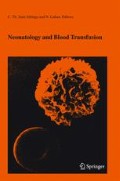Abstract
The blood which remains in the placenta after delivery, also known as placental or cord blood, can be easily collected by venipuncture of the cord vessels. The biological and medical interests in placental blood rose steadily in the last two decades, following the discovery that placental blood contains a number of haemopoietic progenitor cells capable of reconstituting a human myeloablated recipient [1], although the number of cells may be sub-optimal in larger adult patients [2]. Further interest was triggered by recent observations suggesting that haemopoietic progenitor cells can change their developmental programme under strict environmental control, a cell capability termed ‘plasticity’ or ‘transdifferentiation’, which is currently the object of active investigation and hot debate [3]–[11].
Supported in part with grants from Ricerca Finalizzata 2002 (Criobanca automatizzata di materiale biologico); Project QLRT-1999-30887 (Implementation of a cord blood allocation network); Project QLRT-2001-01918 (EUROCORD III).
Access this chapter
Tax calculation will be finalised at checkout
Purchases are for personal use only
Preview
Unable to display preview. Download preview PDF.
References
Gluckman E, Broxmeyer HA, Auerbach AD, et al. Hematopoietic reconstitution in a patient with Fanconi’s anemia by means of umbilical-cord blood from an HLA-identical sibling. N Engl J Med 1989;321:1174–1178.
Laughlin MJ, Barker J, Bambach B, et al. Hematopoietic engraftment and survival in adult recipients of umbilical cord blood from unrelated donors. New Engl J Med 2001;344:1815–1822.
Bjornson CR, Rietze RL, Reynolds BA, Magli MC, Vescovi AL. Turning brain into blood: a hematopoietic fate adopted by adult neural stem cells in vivo. Science 1999;283:534–537.
Zubair AC, Silberstein L, Ritz J. Adult hematopoietic stem cell plasticity. Transfusion 2002;42:1096–1101.
Orlic D, Kajstura J, Chimenti S et al. Bone marrow cells regenerate infarcted myocardium. Nature 2001;410:701–705.
Krause DS, Theise ND, Collector MI, et al. Multi-organ, multi-lineage engraftment by a single bone marrow-derived stem cell. Cell 2001;105:369–377.
Morshead CM, Benveniste P, Iscove NN, van der Kooy D. Hematopoietic competence is a rare property of neural stem cells that may depend on genetic and epigenetic alterations. Nat Med 2002;8:268–273.
McKinney-Freeman SL, Jackson KA, Camargo FD, Ferrari G, Mavilio F, Goodell MA. Muscle-derived hematopoietic stem cells are hematopoietic in origin. Proc Natl Acad Sci USA 2002;99:1341–1346.
Terada N, Hamazaki T, Oka M, et al. Bone marrow cells adopt the phenotype of other cells by spontaneous cell fusion. Nature 2002;416:542–545.
Ying QL, Nichols J, Evans EP, Smith AG. Changing potency by spontaneous fusion. Nature 2002;416:545–548.
Orkin SH, Zon LI. Hematopoiesis and stem cells: plasticity versus developmental heterogeneity. Nat Immunol 2002;3:323–328.
Hakenberg P, Kogler G, Wernet P. NETCORD: a cord blood allocation network. Bone Marrow Transplant 1998;22:S17–S18.
Lazzari L, Corsini C, Curioni C, et al. The Milan Cord Blood Bank and the Italian Cord Blood Network. J Hematother 1996;5:117–122.
Sirchia G, Rebulla P, Lecchi L, Mozzi F, Crepaldi R, Parravicini A. Implementation of a quality system (ISO 9000 Series) for placental blood banking. J Hematotherapy 1998;1:19–35.
Lecchi L, Rebulla P, Ratti I, et al. Outomes of a program to evaluate mother and baby 6 month after umbilical cord blood donation. Transfusion 2001;41:606–610.
Gluckman E. Current status of umbilical cord blood hematopoietic stem cell transplantation [Review]. Exp Hematol 2000;28:1197–1205.
Rubinstein P, Carrier C, Scaradavou A, et al. Outcomes among 562 recipients of placental-blood transplants from unrelated donors. New Engl J Med 1998;339:1565–1577.
Gluckman E, Rocha V, Boyer-Chammard A, et al. Outcome of cord blood transplantation from related and unrelated donors. New Engl J Med 1997;337:373–381.
Barker JN, Davies SM, DeFor T, et al. Survival after transplantation of unrelated donor umbilical cord blood is comparable to that of human leukocyte antigen-matched unrelated donor bone marrow: results of a matchedpair analysis. Blood 2001;97:2957–2961.
Sirchia G, Rebulla P, Tibaldi S, Lecchi L. Cost of umbilical cord blood units released for transplantation. Transfusion 1999;39:645–650.
Author information
Authors and Affiliations
Editor information
Editors and Affiliations
Rights and permissions
Copyright information
© 2005 Springer
About this chapter
Cite this chapter
Lecchi, L., Giovanelli, S., Ratti, I., Cimoni, S., Garcea, F., Rebulla, P. (2005). Placental Blood Banking in the Year 2003. In: Smit Sibinga, C.T., Luban, N. (eds) Neonatology and Blood Transfusion. Developments in Hematology and Immunology, vol 39. Springer, Boston, MA. https://doi.org/10.1007/978-0-387-23600-1_19
Download citation
DOI: https://doi.org/10.1007/978-0-387-23600-1_19
Publisher Name: Springer, Boston, MA
Print ISBN: 978-0-387-23599-8
Online ISBN: 978-0-387-23600-1
eBook Packages: MedicineMedicine (R0)

